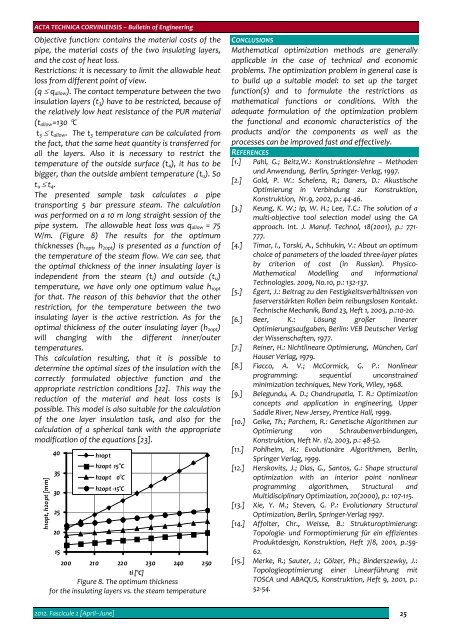Editorial & Advisory Board - Acta Technica Corviniensis
Editorial & Advisory Board - Acta Technica Corviniensis
Editorial & Advisory Board - Acta Technica Corviniensis
You also want an ePaper? Increase the reach of your titles
YUMPU automatically turns print PDFs into web optimized ePapers that Google loves.
ACTA TECHNICA CORVINIENSIS – Bulletin of Engineering<br />
Objective function: contains the material costs of the<br />
pipe, the material costs of the two insulating layers,<br />
and the cost of heat loss.<br />
Restrictions: it is necessary to limit the allowable heat<br />
loss from different point of view.<br />
(q ≤ q allow ). The contact temperature between the two<br />
insulation layers (t 3 ) have to be restricted, because of<br />
the relatively low heat resistance of the PUR material<br />
(t allow =130 °C<br />
t 3 ≤ t allow . The t 3 temperature can be calculated from<br />
the fact, that the same heat quantity is transferred for<br />
all the layers. Also it is necessary to restrict the<br />
temperature of the outside surface (t 4 ), it has to be<br />
bigger, than the outside ambient temperature (t u ). So<br />
t u ≤ t 4 .<br />
The presented sample task calculates a pipe<br />
transporting 5 bar pressure steam. The calculation<br />
was performed on a 10 m long straight session of the<br />
pipe system. The allowable heat loss was q allow = 75<br />
W/m. (Figure 8) The results for the optimum<br />
thicknesses (h 1opt , h 2opt ) is presented as a function of<br />
the temperature of the steam flow. We can see, that<br />
the optimal thickness of the inner insulating layer is<br />
independent from the steam (t i ) and outside (t u )<br />
temperature, we have only one optimum value h 1opt<br />
for that. The reason of this behavior that the other<br />
restriction, for the temperature between the two<br />
insulating layer is the active restriction. As for the<br />
optimal thickness of the outer insulating layer (h 2opt )<br />
will changing with the different inner/outer<br />
temperatures.<br />
This calculation resulting, that it is possible to<br />
determine the optimal sizes of the insulation with the<br />
correctly formulated objective function and the<br />
appropriate restriction conditions [22]. This way the<br />
reduction of the material and heat loss costs is<br />
possible. This model is also suitable for the calculation<br />
of the one layer insulation task, and also for the<br />
calculation of a spherical tank with the appropriate<br />
modification of the equations [23].<br />
h1opt, h2opt [mm]<br />
40<br />
35<br />
30<br />
25<br />
20<br />
15<br />
h1opt<br />
h2opt 15°C<br />
h2opt 0°C<br />
h2opt ‐15°C<br />
200 210 220 230 240 250<br />
ti [°C]<br />
Figure 8. The optimum thickness<br />
for the insulating layers vs. the steam temperature<br />
CONCLUSIONS<br />
Mathematical optimization methods are generally<br />
applicable in the case of technical and economic<br />
problems. The optimization problem in general case is<br />
to build up a suitable model: to set up the target<br />
function(s) and to formulate the restrictions as<br />
mathematical functions or conditions. With the<br />
adequate formulation of the optimization problem<br />
the functional and economic characteristics of the<br />
products and/or the components as well as the<br />
processes can be improved fast and effectively.<br />
REFERENCES<br />
[1.] Pahl, G.; Beitz,W.: Konstruktionslehre – Methoden<br />
und Anwendung, Berlin, Springer‐ Verlag, 1997.<br />
[2.] Gold, P. W.: Schelenz, R.; Daners, D.: Akustische<br />
Optimierung in Verbindung zur Konstruktion,<br />
Konstruktion, Nr.9, 2002, p.: 44‐46.<br />
[3.] Keung, K. W.; Ip, W. H.; Lee, T.C.: The solution of a<br />
multi‐objective tool selection model using the GA<br />
approach. Int. J. Manuf. Technol, 18(2001), p.: 771‐<br />
777.<br />
[4.] Timar, I., Torski, A., Schhukin, V.: About an optimum<br />
choice of parameters of the loaded three‐layer plates<br />
by criterion of cost (in Russian). Physico‐<br />
Mathematical Modelling and Informational<br />
Technologies. 2009, No.10, p.: 132‐137.<br />
[5.] Égert, J.: Beitrag zu den Festigkeitsverhältnissen von<br />
faserverstärkten Rollen beim reibungslosen Kontakt.<br />
Technische Mechanik, Band 23, Heft 1, 2003, p.:10‐20.<br />
[6.] Beer, K.: Lösung großer linearer<br />
Optimierungsaufgaben, Berlin: VEB Deutscher Verlag<br />
der Wissenschaften, 1977.<br />
[7.] Reiner, H.: Nichtlineare Optimierung, München, Carl<br />
Hauser Verlag, 1979.<br />
[8.] Fiacco, A. V.; McCormick, G. P.: Nonlinear<br />
programming: sequential unconstrained<br />
minimization techniques, New York, Wiley, 1968.<br />
[9.] Belegundu, A. D.; Chandrupatla, T. R.: Optimization<br />
concepts and application in engineering, Upper<br />
Saddle River, New Jersey, Prentice Hall, 1999.<br />
[10.] Geike, Th.; Parchem, R.: Genetische Algorithmen zur<br />
Optimierung von Schraubenverbindungen,<br />
Konstruktion, Heft Nr. 1/2, 2003, p.: 48‐52.<br />
[11.] Pohlheim, H.: Evolutionäre Algorithmen, Berlin,<br />
Springer Verlag, 1999.<br />
[12.] Herskovits, J.; Dias, G., Santos, G.: Shape structural<br />
optimization with an interior point nonlinear<br />
programming algorithmen, Structural and<br />
Multidisciplinary Optimization, 20(2000), p.: 107‐115.<br />
[13.] Xie, Y. M.; Steven, G. P.: Evolutionary Structural<br />
Optimization, Berlin, Springer‐Verlag 1997.<br />
[14.] Affolter, Chr., Weisse, B.: Strukturoptimierung:<br />
Topologie‐ und Formoptimierung für ein effizientes<br />
Produktdesign, Konstruktion, Heft 7/8, 2001, p.:59‐<br />
62.<br />
[15.] Merke, R.; Sauter, J.; Gölzer, Ph.; Binderszewky, J.:<br />
Topologieoptimierung einer Linearführung mit<br />
TOSCA und ABAQUS, Konstruktion, Heft 9, 2001, p.:<br />
52‐54.<br />
2012. Fascicule 2 [April–June] 25

















